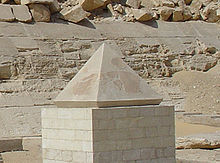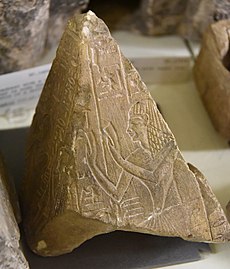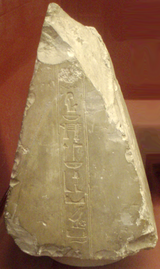
A pyramidion (plural: pyramidia) is the capstone of an Egyptian pyramid or the upper section of an obelisk. Speakers of the Ancient Egyptian language referred to pyramidia as benbenet and associated the pyramid as a whole with the sacred benben stone.
Pyramidia were usually made of limestone, sandstone, basalt or granite, and were sometimes covered with plates of copper, gold or electrum. From the Middle Kingdom onward, they were often "inscribed with royal titles and religious symbols".
Notable pyramidia
See also: List of Egyptian pyramidia
Egyptian Museum
Four pyramidia are housed in the main hall of the Egyptian Museum in Cairo:
- The pyramidion of the so-called Black Pyramid of Amenemhat III at Dahshur
- The pyramidion of the Pyramid of Khendjer at Saqqara
- The pyramidion of Merneferre Ay, probably from Saqqara
- The pyramidion of the Southern South Saqqara pyramid
Red Pyramid

A badly damaged white Tura limestone pyramidion, thought to have been made for the Red Pyramid of Sneferu at Dahshur, has been reconstructed and is on open-air display beside that pyramid; it presents a minor mystery, however, as its angle of inclination is steeper than that of the edifice it was apparently built to surmount.
Private brick pyramids with pyramidia
During the New Kingdom, some private underground tombs were marked on the surface by small brick pyramids that terminated in pyramidia. The four lateral sides included texts and scenes related to the cult of the Sun God (as the representation of Pharaoh).
The scenes typically depict the course of the sun, rising on one lateral face, setting on the opposite face, and traveling, through the night, through the underworld, ruled by Osiris.
Scribe Mose pyramidion
| ||||
| Scribe Moses//Mes,S in hieroglyphs | ||||
|---|---|---|---|---|
The pyramidion of Mose (mes,s, New Kingdom, 19th Dynasty, c. 1250 BC, limestone, 53 cm tall) depicts himself making an offering, with his name on two opposite faces. The adjacent opposite faces feature a baboon: "Screeching upon the rising of the Sun, and the Day". (The baboon is also the god-scribe representation of the Scribe, for the god Thoth.)
Ptahemwia pyramidion
The pyramidion of Ptahemwia (19th Dynasty, Ramesside Period, c. 1200 BC, limestone, 28 cm wide, 42 cm tall) likewise displays sun-related scenes. The Sun God, Re-Horakhti, and the god of the Underworld, Osiris, are shown on one lateral face.
Facing the two gods, on the adjacent lateral face, is the deceased Ptahemwia, standing in an offering pose, facing three columns of hieroglyphs.
Gallery
-
 Pyramidion of the chapel of Nesnubhotep, limestone with relief of a scarab and adoring baboons, 26th Dynasty, Abydos
Pyramidion of the chapel of Nesnubhotep, limestone with relief of a scarab and adoring baboons, 26th Dynasty, Abydos
-
 Pyramidion of Nebamun, limestone, 19th Dynasty, probably from Deir el-Medina
Pyramidion of Nebamun, limestone, 19th Dynasty, probably from Deir el-Medina
-
 Private tomb limestone pyramidion, at the Rosicrucian Egyptian Museum
Private tomb limestone pyramidion, at the Rosicrucian Egyptian Museum
-
 Pyramidion from the tomb of the priest Rer in Abydos, Egypt. Hermitage Museum
Pyramidion from the tomb of the priest Rer in Abydos, Egypt. Hermitage Museum
-
 Pyramidion of Ramose, from Deir el-Medina, 1292–1190 BC (New Kingdom), limestone, Museo Egizio, Turin
Pyramidion of Ramose, from Deir el-Medina, 1292–1190 BC (New Kingdom), limestone, Museo Egizio, Turin
See also
- Washington Monument, which has an aluminum pyramidion
References
- "Pyramidion - Definition of Pyramidion by Merriam-Webster". Retrieved 18 February 2016.
- Ermann, Grapow, Wörterbuch der ägyptischen Sprache 1, 459.13-14
- ^ Toby Wilkinson, The Thames and Hudson Dictionary of Ancient Egypt, Thames & Hudson, 2005. p. 197
- Jánosi, Peter (1992). "Das Pyramidion der Pyramide G III-a. Bemerkungen zu den Pyramidenspitzen des Alten Reiches". Studia Aegyptiaca (in German). 14: 301–308.
- Rammant-Peeters, Agnès (1983). Les pyramidions égyptiens du Nouvel Empire (in French). Peeters Publishers. ISBN 9789070192082.
- Verner, Miroslav (2007). The Pyramids: The Mystery, Culture, and Science of Egypt's Great Monuments. p. 318.
- Edwards, Iorwerth Eiddon Stephen (1993) . The Pyramids of Egypt (Revised ed.). Penguin Group. p. 267. ISBN 9780140136340.
- ^ editors Regine Schulz and Matthias Seidel (w/34 contributing Authors), Egypt, The World of the Pharaohs, Konemann, Germany: 1998. Amenemhat III, 1842–1797 BC p. 115
- "Two Pyramidions of the 13th Dynasty from Ezbet Rushdi El-Kebira (Khatacna)". Annales du Service des Antiquités de l'Egypte. Vol. 52. Le Caire, Impr. de l'Institut français d'archéologie orientale. 1954. pp. 471–479.
- Peck, William. Splendors of Ancient Egypt, William H. Peck, The Detroit Institute of Arts, (University Lithoprinters Inc., Ann Arbor, Mich.), c. 1997, (p. 67). (Moses Pyramidion from "Roemer and Pelizaeus Museum, Hildesheim, Germany".)
External links
| Egyptian pyramids | |||||||||
|---|---|---|---|---|---|---|---|---|---|
| |||||||||
| |||||||||
| Old Kingdom (2686–2181 BC) |
| ||||||||
| 1 Intermediate Period (2181–2040 BC) |
| ||||||||
| Middle Kingdom (2040–1650 BC) |
| ||||||||
| Second Intermediate (1650–1570 BC) |
| ||||||||
| New Kingdom (1570–1070 BC) |
| ||||||||
